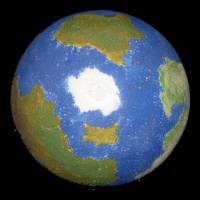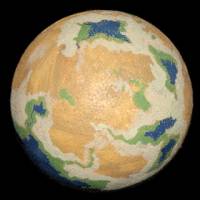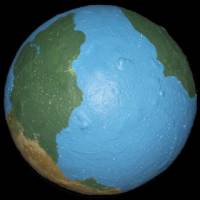This is an old revision of the document!
Planetary Terrain
![]()
There isn't much terrain in space, and planets are probably the nearest thing you would realistically expect to find in a game of Full Thrust. The effect they have on the game depends a lot on how they are represented, and there are three general ways of doing this.
It is possible to model planets as either one edge of the table, or at the other extreme of scales as a point on the table (in the same way that ships are actually points much smaller than their models). In the latter a planet might be 1“ or 2” across, but no larger than that. In both cases planets become objectives rather than terrain.
These rules assume somewhere in between, with planets represented as large objects which block line of sight and movement to a significant degree but small enough to fit entirely on the table.
How Big Is My Planet?
Full Thrust generally ignores scales of either sort (both time and space), but if we want to model a planet then we have to choose a scale in space. Since it is a round number, a scale of 1“ = 1,000km has been chosen. This means an Earth-sized planet is about 13” across, which is about as large as is feasible to have on most gaming tables.
Many planets and moons, such as Mars or The Moon will be much smaller - but they will still be significant terrain features several inches across.
Gravity Sucks
Planets at this scale will have a noticeable gravity well, and to work out what affect this has on ships in the game we also need to fix the time scale. Again, another round number has been chosen, and a turn of 1000s is assumed (16m 40s).
This means that a ship moving at a velocity of 1“ has a real velocity of 1km/s (1” = 1,000km, 1 turn = 1,000s, so 1,000km in 1,000s is 1km/s). It also means that a thrust of 1 is equivalent to an acceleration of about 0.1g. This is quite low, and means ships are generally incapable of taking off from an Earth sized planet.
Modelling Planets
The easiest way to model a planet is to cut a circle out of a piece of cloth or paper, and simply place it on the table top. This also makes it very easy to place planetary installations on the planet, since they can be drawn/placed on top of the planet.
Another easy way is to buy a polystyrene sphere from a craft shop, cut it in half to form a hemisphere and paint it to look planet-like. Most craft shops don't see to have spheres larger than 10cm in diameter, though there's at least one online shop that does very large Polystyrene Balls, up to 2m in diameter. They can be pricey though, and take up a lot of space.



Another technique is to use round MDF bases. I get mine from Products for Wargamers, who will do custom cut bases up to 60cm in diameter. Once painted, they are more sturdy and look better than a bit of cloth or paper, and are cheaper and easier to store than polystyrene hemispheres.
For the size of model to use, some example planets are given below.
| Planet | Size (km) | Size (“) | Atmosphere |
|---|---|---|---|
| Earth | 12,700km | 13” | Standard |
| The Moon | 3,400km | 3“ | Vacuum |
| Mars | 5,700km | 6” | Very Thin |
| Jupiter | 140,000km | 140“ | * |
(*) Since gas giants are almost entirely atmosphere, atmospheric density will vary with altitude.
Unless you are playing on the floor of a large hall, the gas giants aren't practical to use in a game.
Planets as Terrain
If a planet is on the table, then it completely blocks line of sight for purposes of shooting. Ships also cannot move through a planet - if they try to do so, then they will crash and be destroyed.
Many planets are airless, so unless a model actually comes into contact with such a planet then it will avoid it.
If a planet has an atmosphere, then it still may not make much of a difference. Earth's atmosphere is only 10's of kilometres thick, so it's also insignificant on the game board (beyond this altitude it won't have enough effect on the game to be noticeable). If a ship scrapes along the edge of a planet though, then it can be assumed to have encountered the atmosphere.
Atmospheres are considered to be Very Thin, Thin, Standard or Dense.
| Density | Atmosphere Type | Damage | Friction |
|---|---|---|---|
| 0 | Vacuum | – | – |
| 1 | Very Thin | 1/3” | -1“ |
| 2 | Thin | 1/2” | -2“ |
| 3 | Standard | 1/” | -4“ |
| 4 | Dense | 2/” | -8“ |
When encountering an atmosphere, a ship rolls a number of Dice for damage for each 1” of velocity that it has unless it has streamlining. An unstreamlined ship hitting a Standard atmosphere with a velocity of 13“ will roll 6D of damage (as beam dice). This could destroy small ships and damage larger ones.
The ship will also suffer friction. Reduce its velocity for next turn by the number given. This can be a good way to slow down, at the risk of taking significant damage.
A ship with Partial Streamlining can pretend that it's velocity is 6” slower for purposes of taking damage. A ship with Full Streamlining can pretend it is 12“ slower.
A Partially Streamlined ship may choose to halve the friction effect, and a Fully Streamlined ship can choose to halve or completely ignore the friction effect.
